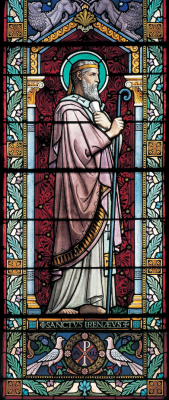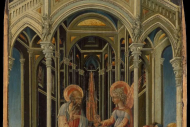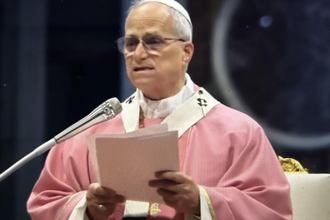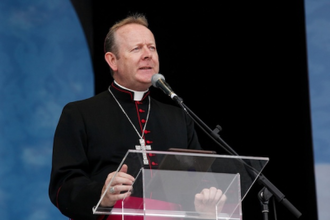Gospel in Art: Saint Irenaeus, Bishop, Doctor and Martyr

Saint Irenaeus. Lucien Bégule window. 1901. St Irenaeus Church, Lyon © Photo Gérald Gambier, Wikimedia Commons
Source: Christian Art
Gospel of 28 June 2024
Matthew 8:1-4
After Jesus had come down from the mountain large crowds followed him. A leper now came up and bowed low in front of him. 'Sir,' he said 'if you want to, you can cure me.' Jesus stretched out his hand, touched him and said, 'Of course I want to! Be cured!' And his leprosy was cured at once. Then Jesus said to him, 'Mind you do not tell anyone, but go and show yourself to the priest and make the offering prescribed by Moses, as evidence for them.'
Reflection on the stained glass window
Today we celebrate the feast of Saint Irenaeus. He was a significant figure in early Christian history, born around 130 AD in Smyrna (modern-day Izmir, Turkey). Irenaeus was a disciple of Polycarp, who himself was a disciple of the Apostle John, thus providing Irenaeus with a direct link to the teachings of Jesus' earliest followers. Around 177 AD Irenaeus became the Bishop of Lyon, France. He played a crucial role in the early Church, both as a pastor and a theologian.
One of Irenaeus' most important contributions to Christian theology is his work 'Adversus Haereses' or 'Against Heresies.' Written around 180 AD, this extensive five-book treatise was a response to the rise of Gnosticism, a movement that posed a significant challenge to orthodox Christian beliefs. Gnosticism taught that salvation could be attained through secret knowledge and often depicted the material world as inherently evil, created by a lesser deity rather than by the supreme God. In this work, Irenaeus systematically refuted these teachings by emphasizing the continuity of the Old and New Testaments, the goodness of creation, and the importance of the Church's tradition and apostolic succession in preserving the true faith.
In his battle against Gnosticism, Irenaeus underscored several key theological points that became foundational for orthodox Christianity. He affirmed the unity and goodness of God, countering the Gnostic belief in a dualistic cosmos with a malevolent creator of the material world. He also stressed the incarnation of Christ, arguing that Jesus, fully God and fully human, redeemed all of humanity and sanctified creation through his life, death, and resurrection. Moreover, Irenaeus highlighted the role of the Church in safeguarding apostolic teaching through a succession of bishops tracing back to the apostles themselves. By doing so, he reinforced the authority of the Church in interpreting Scripture and doctrine.
LINKS
Gospel in Art: https://christian.art/
Today's Reflection: https://christian.art/daily-gospel-reading/matthew-8-1-4-2024/


















